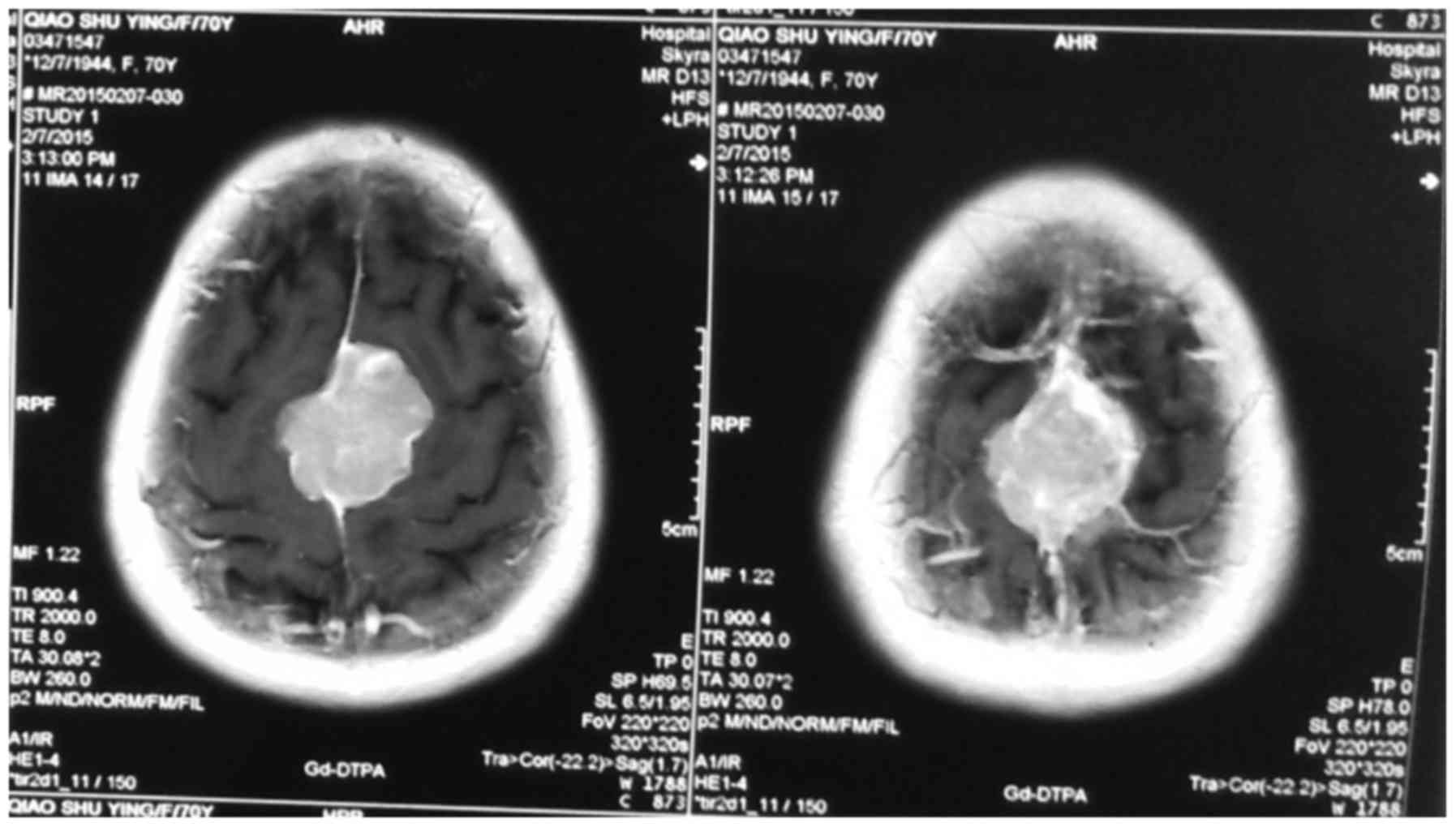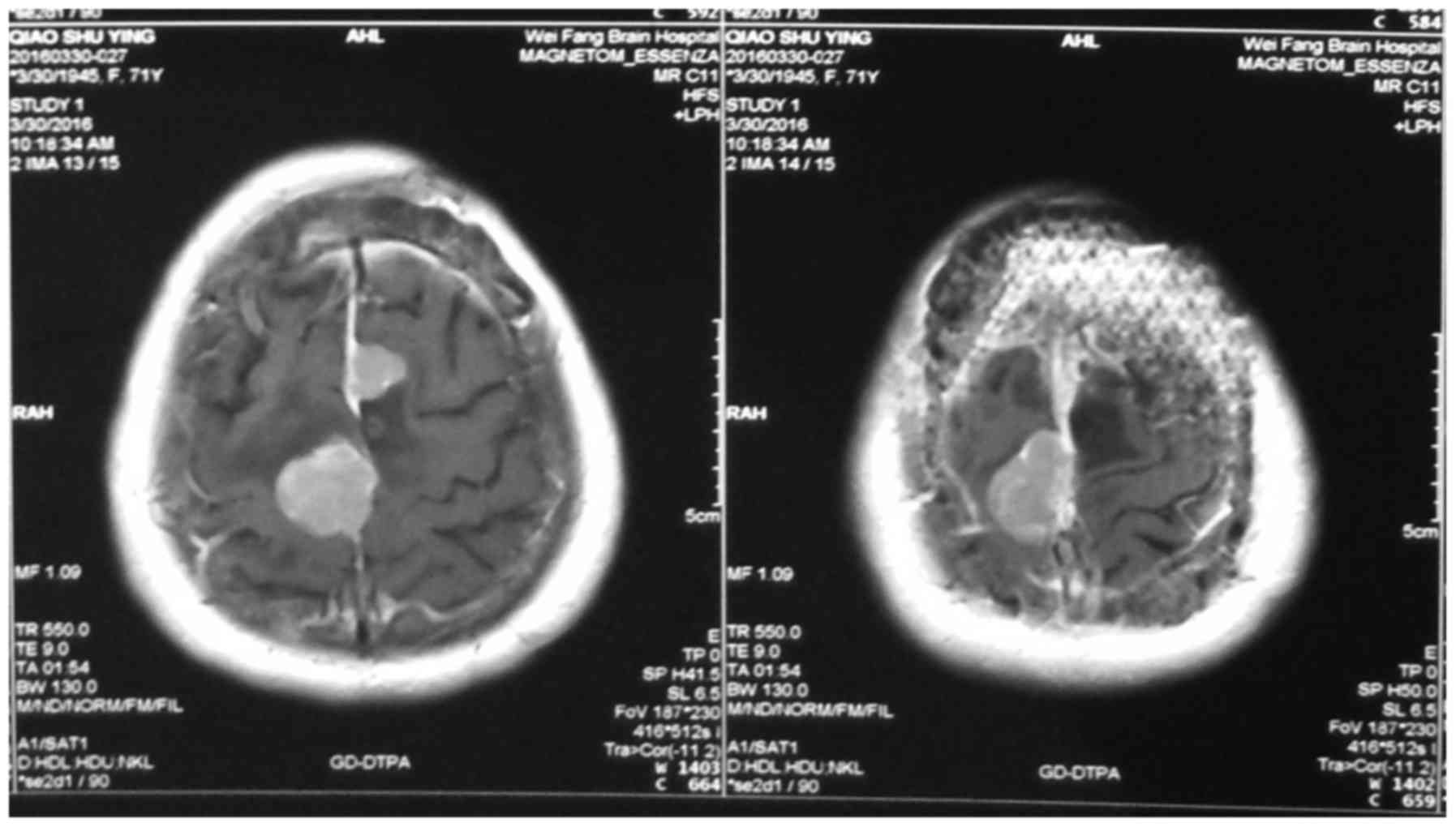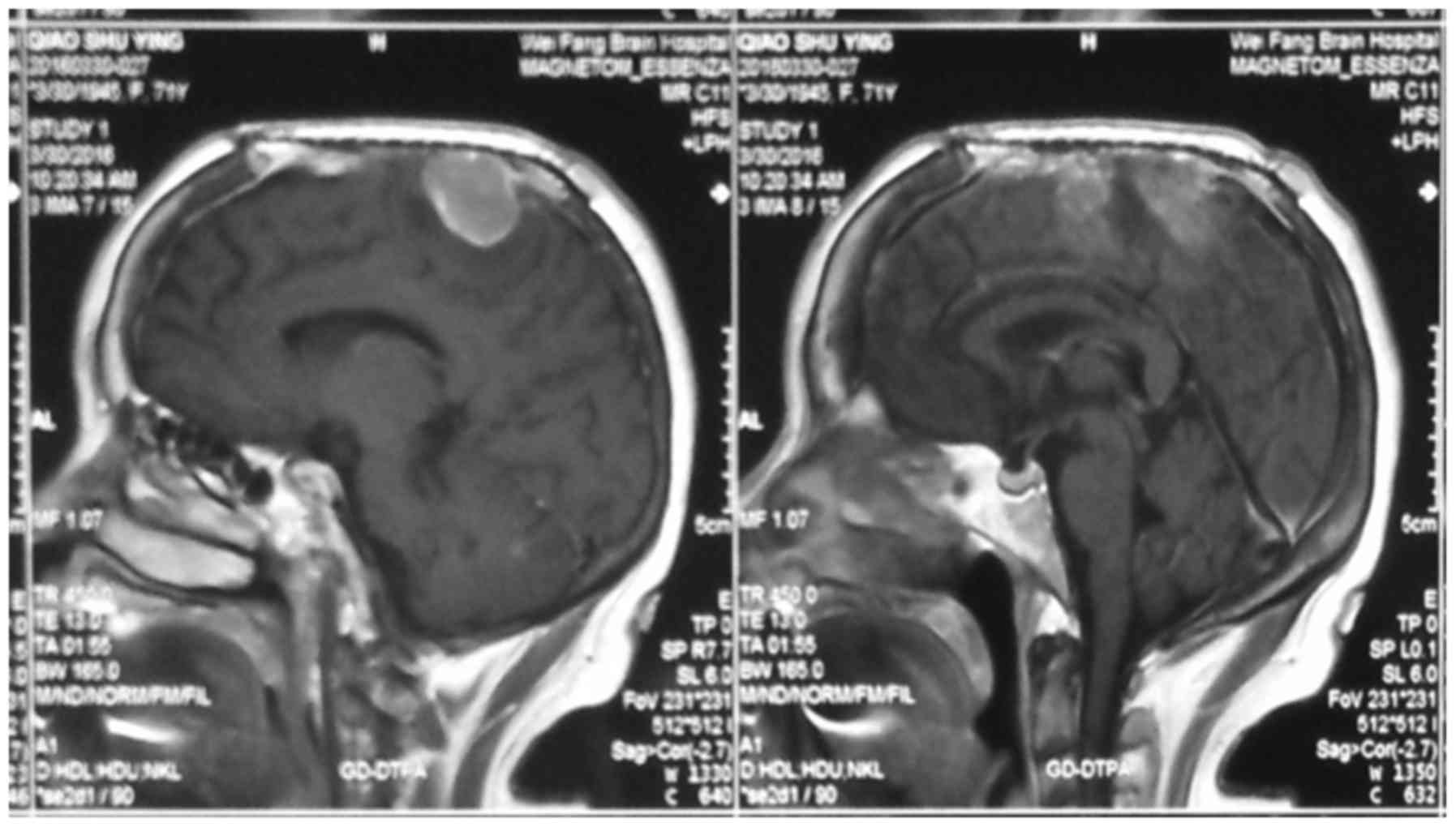|
1
|
Gelabert-González M and Serramito-García
R: Intracranial meningiomas: I. Epidemiology, aetiology,
pathogenesis and prognostic factors. Rev Neurol. 53:165–172.
2011.(In Spanish). PubMed/NCBI
|
|
2
|
Bondy M and Ligon BL: Epidemiology and
etiology of intracranial meningiomas: a review. J Neurooncol.
29:197–205. 1996. View Article : Google Scholar : PubMed/NCBI
|
|
3
|
Hanft S, Canoll P and Bruce JN: A review
of malignant meningiomas: diagnosis, characteristics, and
treatment. J Neurooncol. 99:433–443. 2010. View Article : Google Scholar : PubMed/NCBI
|
|
4
|
Rockhill J, Mrugala M and Chamberlain MC:
Intracranial meningiomas: an overview of diagnosis and treatment.
Neurosurg Focus. 23:E12007. View Article : Google Scholar : PubMed/NCBI
|
|
5
|
Zhang S, Meng H, Gui Y, Chen L, Zhao T,
Zhang X, Li G and Yang G: On diagnostics of malignant meningioma
and invasive meningioma. Hua Xi Yi Ke Da Xue Xue Bao. 27:192–195.
1996.(In Chinese). PubMed/NCBI
|
|
6
|
Yamazaki T, Takahashi S, Ishii K,
Matsumoto K, Ishibashi T, Sakamoto K and Ogawa A: Meningioma in the
pineal region: preoperative diagnosis with CT, MRI, and
angiography. Radiat Med. 9:22–25. 1991.PubMed/NCBI
|
|
7
|
Chen XR: CT diagnosis of meningioma
(analysis of 215 cases). Zhonghua Fang She Xue Za Zhi. 20:292–295.
1986.(In Chinese). PubMed/NCBI
|
|
8
|
Freeman AC, Platt SR, Kent M and
Hofmeister E: What is the evidence? Diagnosis of an intracranial
lesion as a meningioma on the basis of MRI characteristics. J Am
Vet Med Assoc. 239:60–62. 2011. View Article : Google Scholar : PubMed/NCBI
|
|
9
|
Huang SQ, Liang BL, Xie BK, Yuan JP, Zhong
JL and Ye RX: MRI performance and diagnosis of meningioma - a
report of 126 cases. Ai Zheng. 23:1329–1333. 2004.PubMed/NCBI
|
|
10
|
Jain D, Ebrahimi KB, Miller NR and
Eberhart CG: Intraorbital meningiomas: a pathologic review using
current World Health Organization criteria. Arch Pathol Lab Med.
134:766–770. 2010.PubMed/NCBI
|
|
11
|
Nanda A, Bir SC, Maiti TK, Konar SK,
Missios S and Guthikonda B: Relevance of Simpson grading system and
recurrence-free survival after surgery for World Health
Organization Grade I meningioma. J Neurosurg. 126:201–211. 2017.
View Article : Google Scholar : PubMed/NCBI
|
|
12
|
Fisher JL, Schwartzbaum JA, Wrensch M and
Wiemels JL: Epidemiology of brain tumors. Neurol Clin. 25:867–890.
2007. View Article : Google Scholar : PubMed/NCBI
|
|
13
|
Wrensch M, Minn Y, Chew T, Bondy M and
Berger MS: Epidemiology of primary brain tumors: current concepts
and review of the literature. Neuro Oncol. 4:278–299. 2002.
View Article : Google Scholar : PubMed/NCBI
|
|
14
|
Huairong L, Peng S and Yaping Z: Detection
for single nucleotide polymorphisms. Hereditas. 23:471–476.
2001.
|
|
15
|
Chunxia Z, Xianzhe S and Shen L: Recent
advances in single nucleotide polymorphism of human genome
research. Chinese J Chromatog. 21:110–114. 2003.(In Chinese).
|
|
16
|
Younis GA, Sawaya R, DeMonte F, Hess KR,
Albrecht S and Bruner JM: Aggressive meningeal tumors: review of a
series. J Neurosurg. 82:17–27. 1995. View Article : Google Scholar : PubMed/NCBI
|
|
17
|
Sołtys J, Pietniczka-Załeska M,
Młyńczyk-Budzynowska K and Majkowski J: Neoplasms of paranasal
sinuses in material of ENT Department MSS Hospital in Warsaw
between 2006–2007. Otolaryngol Pol. 62:451–454. 2008.(In Polish).
View Article : Google Scholar : PubMed/NCBI
|
|
18
|
Iaconetta G, Santella A, Friscia M, Abbate
V and Califano L: Extracranial primary and secondary meningiomas.
Int J Oral Maxillofac Surg. 41:211–217. 2012. View Article : Google Scholar : PubMed/NCBI
|
|
19
|
Yamashima T, Kida S and Yamamoto S:
Ultrastructural comparison of arachnoid villi and meningiomas in
man. Mod Pathol. 1:224–234. 1988.PubMed/NCBI
|
|
20
|
Daneshi A, Asghari A and Bahramy E:
Primary meningioma of the ethmoid sinus: a case report. Ear Nose
Throat J. 82:310–311. 2003.PubMed/NCBI
|
|
21
|
Preston DL, Ron E, Yonehara S, Kobuke T,
Fujii H, Kishikawa M, Tokunaga M, Tokuoka S and Mabuchi K: Tumors
of the nervous system and pituitary gland associated with atomic
bomb radiation exposure. J Natl Cancer Inst. 94:1555–1563. 2002.
View Article : Google Scholar : PubMed/NCBI
|
|
22
|
Ron E, Modan B, Boice JD Jr, Alfandary E,
Stovall M, Chetrit A and Katz L: Tumors of the brain and nervous
system after radiotherapy in childhood. N Engl J Med.
319:1033–1039. 1988. View Article : Google Scholar : PubMed/NCBI
|
|
23
|
Yamada SM, Yamada S, Takahashi H, Teramoto
A and Matsumoto K: Extracranially extended meningothelial
meningiomas with a high MIB-1 index: a report of two cases.
Neuropathology. 24:66–71. 2004. View Article : Google Scholar : PubMed/NCBI
|
|
24
|
Lombardi D, Tomenzoli D, Buttà L, Bizzoni
A, Farina D, Sberze F, Karligkiotis A, Castelnuovo P and Nicolai P:
Limitations and complications of endoscopic surgery for treatment
for sinonasal inverted papilloma: a reassessment after 212 cases.
Head Neck. 33:1154–1161. 2011. View Article : Google Scholar : PubMed/NCBI
|
|
25
|
Busquets JM and Hwang PH: Endoscopic
resection of sinonasal inverted papilloma: a meta-analysis.
Otolaryngol Head Neck Surg. 134:476–482. 2006. View Article : Google Scholar : PubMed/NCBI
|
|
26
|
Gotlib T, Osuch-Wójcikiewicz E,
Held-Ziółkowska M, Kużmińska M and Niemczyk K: Endoscopic
transnasal management of sinonasal malignancies - our initial
experience. Wideochir Inne Tech Malo Inwazyjne. 9:131–137.
2014.PubMed/NCBI
|
|
27
|
Lund VJ, Stammberger H, Nicolai P,
Castelnuovo P, Beal T, Beham A, Bernal-Sprekelsen M, Braun H,
Cappabianca P, Carrau R, et al: European Rhinologic Society
Advisory Board on Endoscopic Techniques in the Management of Nose,
Paranasal Sinus and Skull Base Tumours: European position paper on
endoscopic management of tumours of the nose, paranasal sinuses and
skull base. Rhinol. 22:(Suppl). 1–143. 2010.
|












